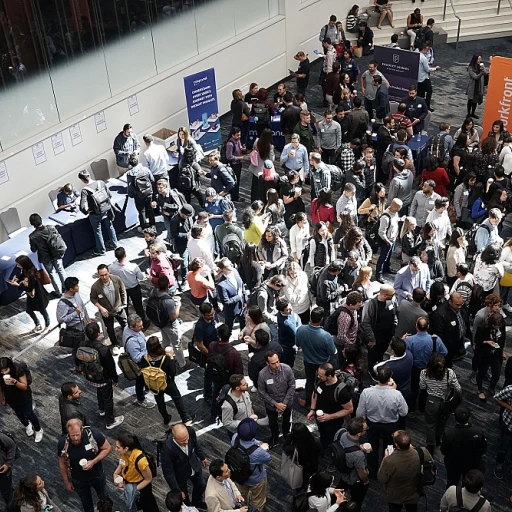
Understanding Employee Engagement
Why Employee Engagement Matters
In today's fast-paced work environment, keeping employees engaged is more important than ever. Employee engagement is not just about keeping your team members happy; it directly impacts productivity, job satisfaction, and the overall success of a company. When employees feel valued and engaged, they contribute positively to the workplace culture, helping to boost morale and job satisfaction.
Key Elements of Engagement
Engaged employees are those who feel connected to their company and are motivated to contribute to its success. This connection can be nurtured through meaningful activities, peer recognition, and professional development opportunities. Providing regular feedback and creating a culture where employees feel heard and appreciated can make a significant difference in their level of engagement.
Impact on Company Culture
A strong company culture that encourages employees to share ideas and collaborate is essential for fostering engagement. Team building activities and inexpensive employee engagement ideas can help build a positive and inclusive workplace environment. When team members are recognized for their efforts and feel a sense of belonging, they are more likely to stay engaged and committed to their work.
The Business Case for Engagement
Investing time and resources in employee engagement leads to better performance and reduced turnover. Engaged employees are more innovative, willing to go the extra mile, and contribute towards a strong team dynamic. To understand the transformation of employee engagement through HR tools, you can learn more here.
The Role of AI in Enhancing Engagement
AI as a Catalyst for Improved Engagement
Artificial Intelligence (AI) is transforming how companies can foster deeper connections between their employees and the workplace. By leveraging AI technology, HR teams can tap into a wealth of insights that help create more meaningful engagement activities, ensuring employees feel valued and recognized.
One key aspect of AI is its ability to streamline communication within teams. By adopting AI-driven communication tools, companies can enhance feedback mechanisms, ensuring employees' voices are heard and understood. These tools can aggregate team members' feedback and provide actionable insights into improving workplace culture and morale.
AI also plays a crucial role in tailoring professional development opportunities. By analyzing employees' skills and interests, AI can suggest personalized learning and development paths that encourage continuous growth. This personalization helps in showing employees that the company invests in their professional journey, which boosts job satisfaction and engagement.
Engagement Insights from AI
AI can gather and analyze data to uncover trends in employee engagement, offering valuable engagement ideas to HR departments. By identifying patterns in how employees interact with their work and colleagues, AI can help in designing inexpensive employee engagement activities that resonate with team members. These activities can cement a sense of belonging and camaraderie within the office.
Moreover, AI tools can track and highlight peer recognition moments, reinforcing a positive workplace environment. Acknowledging these moments amplifies the feeling of gratitude and respect among employees, creating a stronger, more cohesive company culture.
To learn more about the transformative effects of AI on employee engagement, explore this analysis on AI's impact in HR practices.
Cost-Effective AI Tools for HR
Leveraging AI-Based Engagement Tools for Budget-Conscious Enterprises
Artificial intelligence can significantly enhance team engagement, but not all solutions require vast expenditures. In fact, there are numerous affordable options that can efficiently integrate AI into your HR operations, ensuring all team members benefit without straining company resources. One effective and affordable tool is AI-driven feedback platforms. These platforms collect and analyze employee feedback, offering insights into engagement levels and areas needing improvement. By facilitating continuous peer recognition and feedback, companies can help employees feel more valued and heard in their roles. Moreover, AI chatbots can play a key role in boosting morale by automating routine HR inquiries and allowing HR teams to focus on more strategic tasks. The efficiency gained not only enhances office responsiveness but also enables team members to spend more time on creative and productive activities. Incorporating AI solutions like virtual team building applications can also encourage employees through regularly organized engagement activities. These platforms offer personalized recommendations for professional development and inexpensive employee engagement activities, ensuring everyone stays involved and engaged. Utilizing affordable scheduling and communication tools can foster a more inclusive workplace culture. By easing the coordination of team-building exercises and day-to-day operations, these tools can create a more streamlined and cohesive work environment. To delve deeper into how AI can enhance horizontal communication in the workplace, explore enhancing workplace dynamics with AI. This approach not only empowers teams but also builds a stronger company culture by advocating for transparent and consistent communication.Implementing AI Solutions on a Budget
Maximizing AI Benefits Without Breaking the Bank
Implementing AI solutions in human resources doesn't have to be a costly affair. With a strategic approach, companies can leverage AI to boost employee engagement while keeping expenses in check. Here are some practical steps to consider:
- Start Small: Begin with AI tools that offer free trials or basic versions. This allows your team to explore functionalities without a financial commitment. As your team members become more familiar, you can gradually scale up to more comprehensive solutions.
- Focus on Specific Needs: Identify the key areas where AI can make the most impact. Whether it's enhancing feedback mechanisms or streamlining peer recognition, targeting specific needs ensures that resources are used efficiently.
- Leverage Existing Platforms: Many companies already use platforms that offer AI integrations. Explore these options to enhance your current systems without additional costs. This can help employees feel more comfortable as they adapt to new technologies.
- Encourage Employee Involvement: Involve employees in the selection process of AI tools. When teams feel valued and part of the decision-making process, it boosts morale and engagement. This also helps in creating a workplace culture that embraces innovation.
- Utilize Open Source Solutions: Open source AI tools can be a cost-effective way to introduce AI into your HR processes. These tools often have active communities that provide support and ideas for implementation.
- Invest in Training: While the initial investment in training might seem counterintuitive to saving money, it is crucial for long-term success. Training helps employees understand and utilize AI tools effectively, leading to greater job satisfaction and engagement.
By carefully selecting and implementing AI solutions, companies can enhance their workplace culture and create an environment where employees feel engaged and valued. This approach not only boosts employee morale but also contributes to the overall success of the organization.
Measuring the Impact of AI on Engagement
Evaluating Engagement Impact
One of the critical aspects of implementing AI in human resources is understanding the measurable impact on employee engagement within your company. Reliable metrics are key to this understanding, allowing HR professionals to assess improvements comprehensively. Here are several methods to evaluate how your AI-driven strategies are influencing employee engagement:- Sentiment Analysis: Utilize AI tools to analyze employee feedback, whether through surveys, review platforms, or casual day-to-day interactions. Sentiment analysis can help identify how team members feel about their workplace and highlight areas for improvement in the company's culture.
- Employee Surveys: Conduct regular surveys, focusing on peer recognition, engagement activities, or professional development opportunities. AI can automate the analysis of these surveys, offering insights into whether employees feel valued and motivated.
- Productivity and Performance: Monitor any changes in productivity levels. Engaged employees often show enhanced job satisfaction, which can translate into increased productivity. AI can help employees through automated tracking of these performance metrics to spot patterns over time.
- Retention Rates: An engaged workforce typically experiences lower turnover. Tracking retention rates can provide insight into whether your engagement strategies are working and which team building or development programs contribute most effectively to employee loyalty.
- Office Atmosphere Assessment: Leverage AI to collect feedback on the office atmosphere and workplace culture. Engaged employees are more likely to participate in team-building activities and share ideas, creating a positive and dynamic environment.












